ICT351 Assignment: Smith Engineering Tender Template Analysis Report
VerifiedAdded on 2022/09/14
|10
|2281
|21
Case Study
AI Summary
This case study analyzes the ethical considerations within Smith Engineering, an Australian civil engineering firm, concerning the selection of a tender template. The report, structured using the 'Doing Ethics Technique,' examines the situation where the CIO promotes ReportBase, while the head of the department, Gary Tallent, has a relationship with the company. The analysis reveals conflicts of interest, as an alternative product, ReportBuilder, is found to be cheaper, and an in-house analyst has developed a potentially superior content management tool. The report identifies stakeholders affected, ethical implications, and suggests solutions, including a SWOT analysis of all available options. The conclusion supports the use of the analyst's self-developed tool based on performance and cost-effectiveness, emphasizing ethical decision-making and professional practice in ICT.
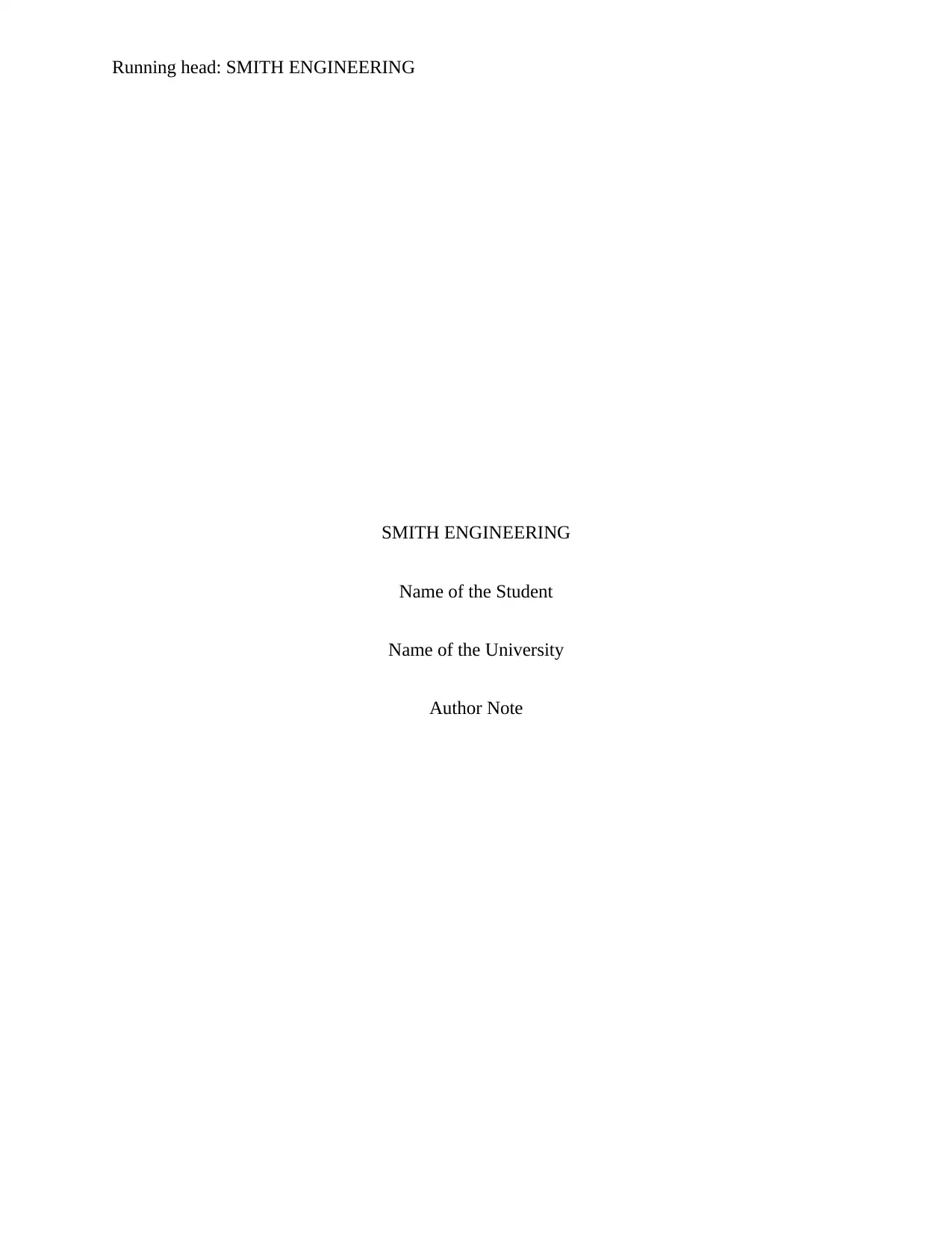
Running head: SMITH ENGINEERING
SMITH ENGINEERING
Name of the Student
Name of the University
Author Note
SMITH ENGINEERING
Name of the Student
Name of the University
Author Note
Paraphrase This Document
Need a fresh take? Get an instant paraphrase of this document with our AI Paraphraser
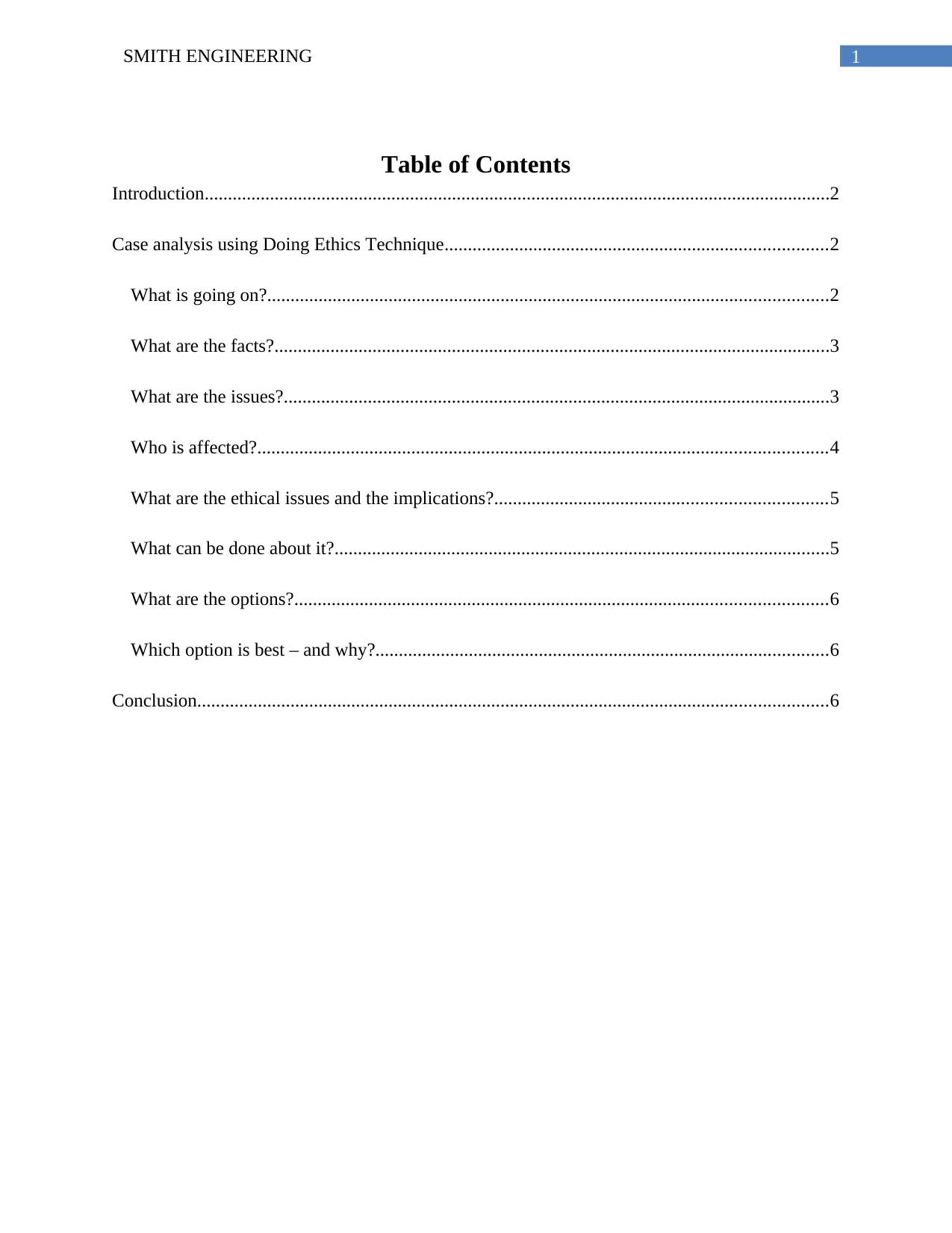
1SMITH ENGINEERING
Table of Contents
Introduction......................................................................................................................................2
Case analysis using Doing Ethics Technique..................................................................................2
What is going on?........................................................................................................................2
What are the facts?.......................................................................................................................3
What are the issues?.....................................................................................................................3
Who is affected?..........................................................................................................................4
What are the ethical issues and the implications?.......................................................................5
What can be done about it?..........................................................................................................5
What are the options?..................................................................................................................6
Which option is best – and why?.................................................................................................6
Conclusion.......................................................................................................................................6
Table of Contents
Introduction......................................................................................................................................2
Case analysis using Doing Ethics Technique..................................................................................2
What is going on?........................................................................................................................2
What are the facts?.......................................................................................................................3
What are the issues?.....................................................................................................................3
Who is affected?..........................................................................................................................4
What are the ethical issues and the implications?.......................................................................5
What can be done about it?..........................................................................................................5
What are the options?..................................................................................................................6
Which option is best – and why?.................................................................................................6
Conclusion.......................................................................................................................................6
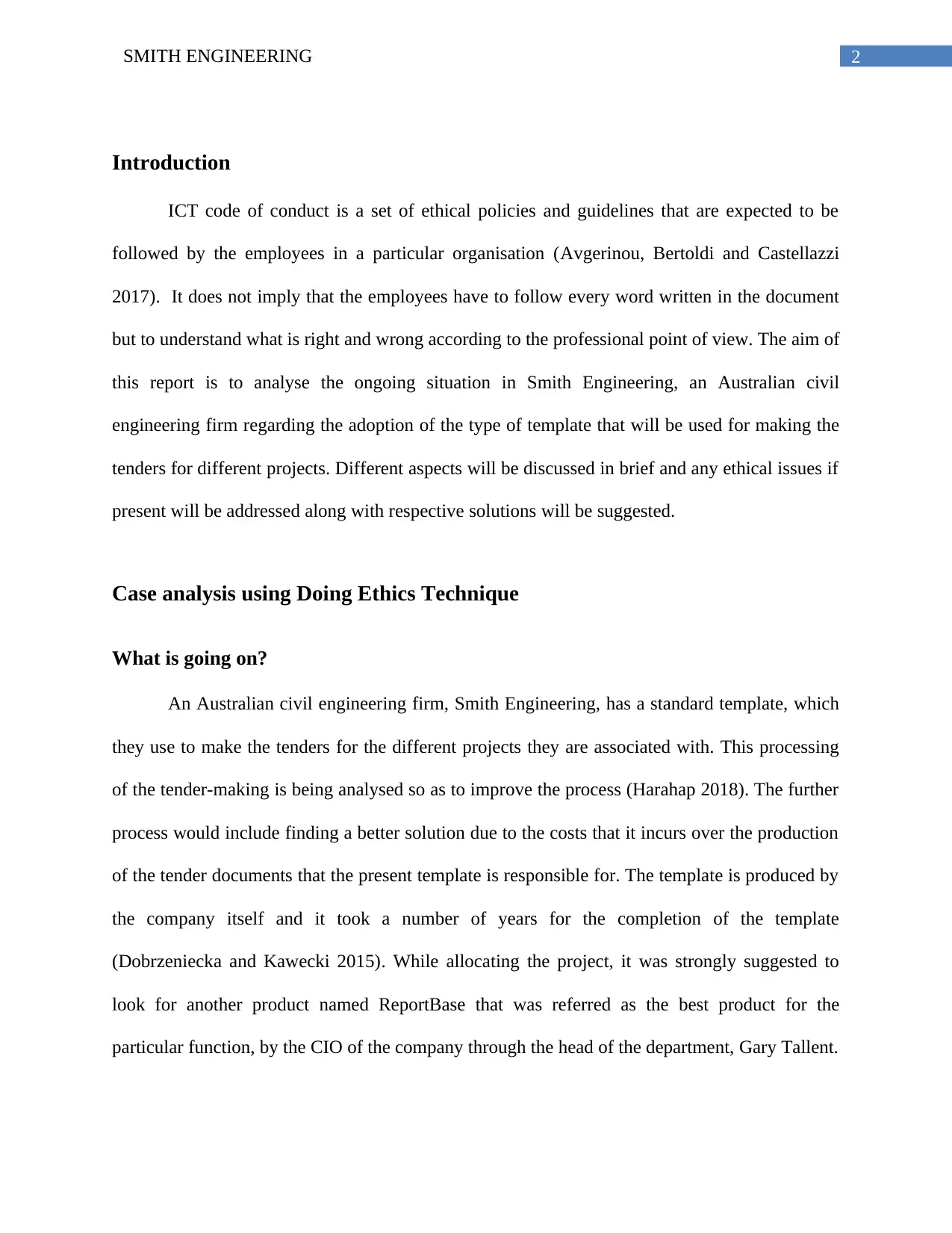
2SMITH ENGINEERING
Introduction
ICT code of conduct is a set of ethical policies and guidelines that are expected to be
followed by the employees in a particular organisation (Avgerinou, Bertoldi and Castellazzi
2017). It does not imply that the employees have to follow every word written in the document
but to understand what is right and wrong according to the professional point of view. The aim of
this report is to analyse the ongoing situation in Smith Engineering, an Australian civil
engineering firm regarding the adoption of the type of template that will be used for making the
tenders for different projects. Different aspects will be discussed in brief and any ethical issues if
present will be addressed along with respective solutions will be suggested.
Case analysis using Doing Ethics Technique
What is going on?
An Australian civil engineering firm, Smith Engineering, has a standard template, which
they use to make the tenders for the different projects they are associated with. This processing
of the tender-making is being analysed so as to improve the process (Harahap 2018). The further
process would include finding a better solution due to the costs that it incurs over the production
of the tender documents that the present template is responsible for. The template is produced by
the company itself and it took a number of years for the completion of the template
(Dobrzeniecka and Kawecki 2015). While allocating the project, it was strongly suggested to
look for another product named ReportBase that was referred as the best product for the
particular function, by the CIO of the company through the head of the department, Gary Tallent.
Introduction
ICT code of conduct is a set of ethical policies and guidelines that are expected to be
followed by the employees in a particular organisation (Avgerinou, Bertoldi and Castellazzi
2017). It does not imply that the employees have to follow every word written in the document
but to understand what is right and wrong according to the professional point of view. The aim of
this report is to analyse the ongoing situation in Smith Engineering, an Australian civil
engineering firm regarding the adoption of the type of template that will be used for making the
tenders for different projects. Different aspects will be discussed in brief and any ethical issues if
present will be addressed along with respective solutions will be suggested.
Case analysis using Doing Ethics Technique
What is going on?
An Australian civil engineering firm, Smith Engineering, has a standard template, which
they use to make the tenders for the different projects they are associated with. This processing
of the tender-making is being analysed so as to improve the process (Harahap 2018). The further
process would include finding a better solution due to the costs that it incurs over the production
of the tender documents that the present template is responsible for. The template is produced by
the company itself and it took a number of years for the completion of the template
(Dobrzeniecka and Kawecki 2015). While allocating the project, it was strongly suggested to
look for another product named ReportBase that was referred as the best product for the
particular function, by the CIO of the company through the head of the department, Gary Tallent.
⊘ This is a preview!⊘
Do you want full access?
Subscribe today to unlock all pages.

Trusted by 1+ million students worldwide
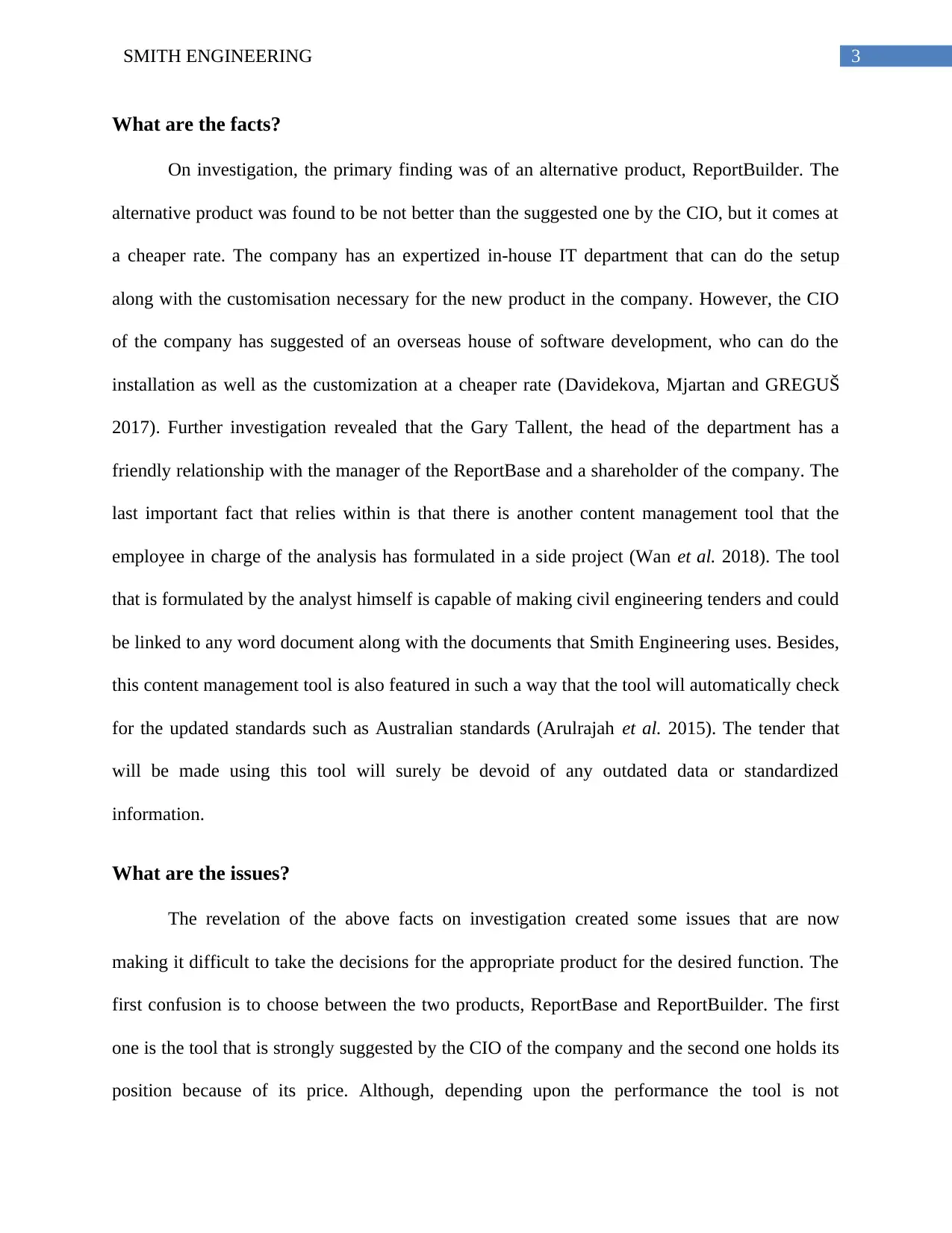
3SMITH ENGINEERING
What are the facts?
On investigation, the primary finding was of an alternative product, ReportBuilder. The
alternative product was found to be not better than the suggested one by the CIO, but it comes at
a cheaper rate. The company has an expertized in-house IT department that can do the setup
along with the customisation necessary for the new product in the company. However, the CIO
of the company has suggested of an overseas house of software development, who can do the
installation as well as the customization at a cheaper rate (Davidekova, Mjartan and GREGUŠ
2017). Further investigation revealed that the Gary Tallent, the head of the department has a
friendly relationship with the manager of the ReportBase and a shareholder of the company. The
last important fact that relies within is that there is another content management tool that the
employee in charge of the analysis has formulated in a side project (Wan et al. 2018). The tool
that is formulated by the analyst himself is capable of making civil engineering tenders and could
be linked to any word document along with the documents that Smith Engineering uses. Besides,
this content management tool is also featured in such a way that the tool will automatically check
for the updated standards such as Australian standards (Arulrajah et al. 2015). The tender that
will be made using this tool will surely be devoid of any outdated data or standardized
information.
What are the issues?
The revelation of the above facts on investigation created some issues that are now
making it difficult to take the decisions for the appropriate product for the desired function. The
first confusion is to choose between the two products, ReportBase and ReportBuilder. The first
one is the tool that is strongly suggested by the CIO of the company and the second one holds its
position because of its price. Although, depending upon the performance the tool is not
What are the facts?
On investigation, the primary finding was of an alternative product, ReportBuilder. The
alternative product was found to be not better than the suggested one by the CIO, but it comes at
a cheaper rate. The company has an expertized in-house IT department that can do the setup
along with the customisation necessary for the new product in the company. However, the CIO
of the company has suggested of an overseas house of software development, who can do the
installation as well as the customization at a cheaper rate (Davidekova, Mjartan and GREGUŠ
2017). Further investigation revealed that the Gary Tallent, the head of the department has a
friendly relationship with the manager of the ReportBase and a shareholder of the company. The
last important fact that relies within is that there is another content management tool that the
employee in charge of the analysis has formulated in a side project (Wan et al. 2018). The tool
that is formulated by the analyst himself is capable of making civil engineering tenders and could
be linked to any word document along with the documents that Smith Engineering uses. Besides,
this content management tool is also featured in such a way that the tool will automatically check
for the updated standards such as Australian standards (Arulrajah et al. 2015). The tender that
will be made using this tool will surely be devoid of any outdated data or standardized
information.
What are the issues?
The revelation of the above facts on investigation created some issues that are now
making it difficult to take the decisions for the appropriate product for the desired function. The
first confusion is to choose between the two products, ReportBase and ReportBuilder. The first
one is the tool that is strongly suggested by the CIO of the company and the second one holds its
position because of its price. Although, depending upon the performance the tool is not
Paraphrase This Document
Need a fresh take? Get an instant paraphrase of this document with our AI Paraphraser
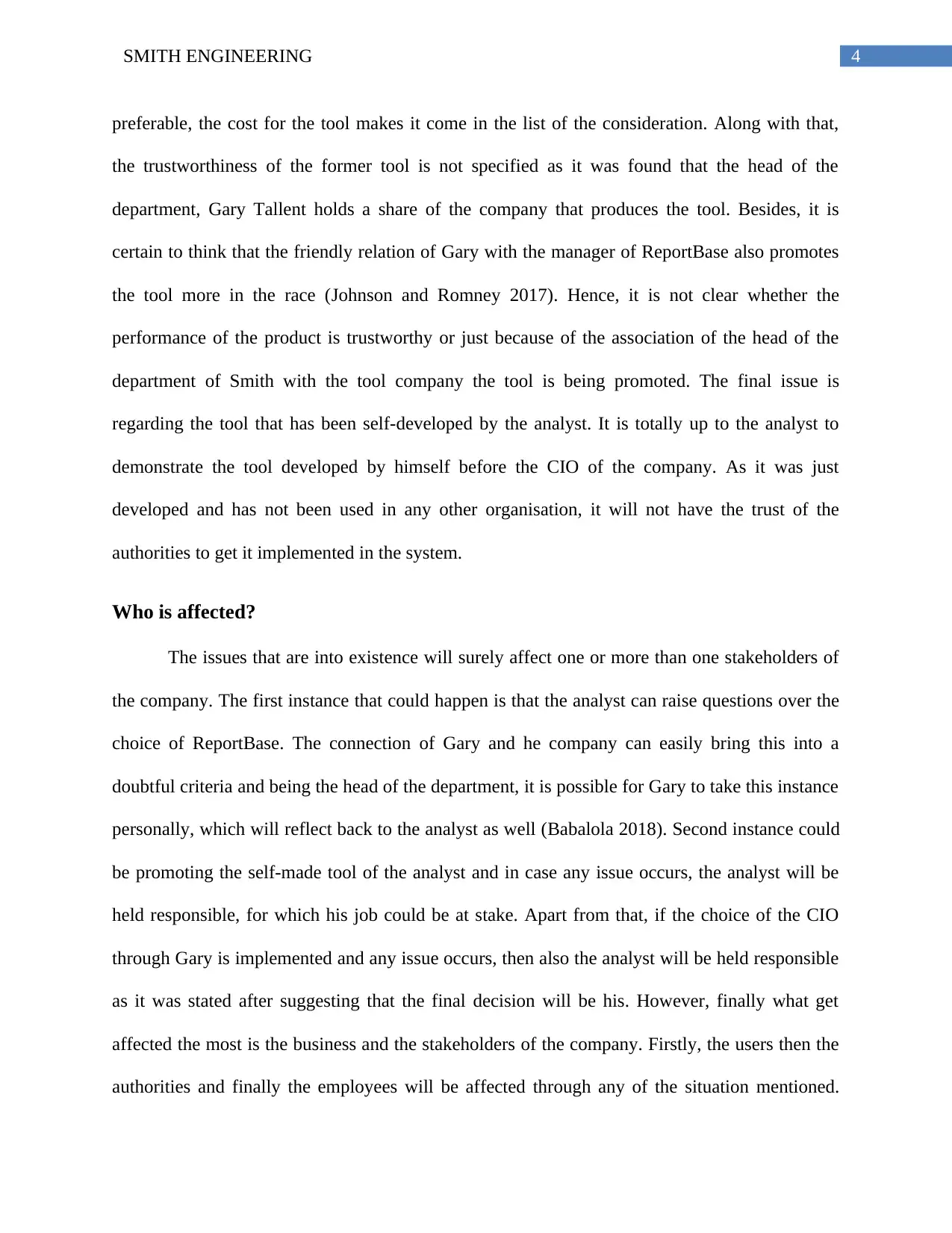
4SMITH ENGINEERING
preferable, the cost for the tool makes it come in the list of the consideration. Along with that,
the trustworthiness of the former tool is not specified as it was found that the head of the
department, Gary Tallent holds a share of the company that produces the tool. Besides, it is
certain to think that the friendly relation of Gary with the manager of ReportBase also promotes
the tool more in the race (Johnson and Romney 2017). Hence, it is not clear whether the
performance of the product is trustworthy or just because of the association of the head of the
department of Smith with the tool company the tool is being promoted. The final issue is
regarding the tool that has been self-developed by the analyst. It is totally up to the analyst to
demonstrate the tool developed by himself before the CIO of the company. As it was just
developed and has not been used in any other organisation, it will not have the trust of the
authorities to get it implemented in the system.
Who is affected?
The issues that are into existence will surely affect one or more than one stakeholders of
the company. The first instance that could happen is that the analyst can raise questions over the
choice of ReportBase. The connection of Gary and he company can easily bring this into a
doubtful criteria and being the head of the department, it is possible for Gary to take this instance
personally, which will reflect back to the analyst as well (Babalola 2018). Second instance could
be promoting the self-made tool of the analyst and in case any issue occurs, the analyst will be
held responsible, for which his job could be at stake. Apart from that, if the choice of the CIO
through Gary is implemented and any issue occurs, then also the analyst will be held responsible
as it was stated after suggesting that the final decision will be his. However, finally what get
affected the most is the business and the stakeholders of the company. Firstly, the users then the
authorities and finally the employees will be affected through any of the situation mentioned.
preferable, the cost for the tool makes it come in the list of the consideration. Along with that,
the trustworthiness of the former tool is not specified as it was found that the head of the
department, Gary Tallent holds a share of the company that produces the tool. Besides, it is
certain to think that the friendly relation of Gary with the manager of ReportBase also promotes
the tool more in the race (Johnson and Romney 2017). Hence, it is not clear whether the
performance of the product is trustworthy or just because of the association of the head of the
department of Smith with the tool company the tool is being promoted. The final issue is
regarding the tool that has been self-developed by the analyst. It is totally up to the analyst to
demonstrate the tool developed by himself before the CIO of the company. As it was just
developed and has not been used in any other organisation, it will not have the trust of the
authorities to get it implemented in the system.
Who is affected?
The issues that are into existence will surely affect one or more than one stakeholders of
the company. The first instance that could happen is that the analyst can raise questions over the
choice of ReportBase. The connection of Gary and he company can easily bring this into a
doubtful criteria and being the head of the department, it is possible for Gary to take this instance
personally, which will reflect back to the analyst as well (Babalola 2018). Second instance could
be promoting the self-made tool of the analyst and in case any issue occurs, the analyst will be
held responsible, for which his job could be at stake. Apart from that, if the choice of the CIO
through Gary is implemented and any issue occurs, then also the analyst will be held responsible
as it was stated after suggesting that the final decision will be his. However, finally what get
affected the most is the business and the stakeholders of the company. Firstly, the users then the
authorities and finally the employees will be affected through any of the situation mentioned.
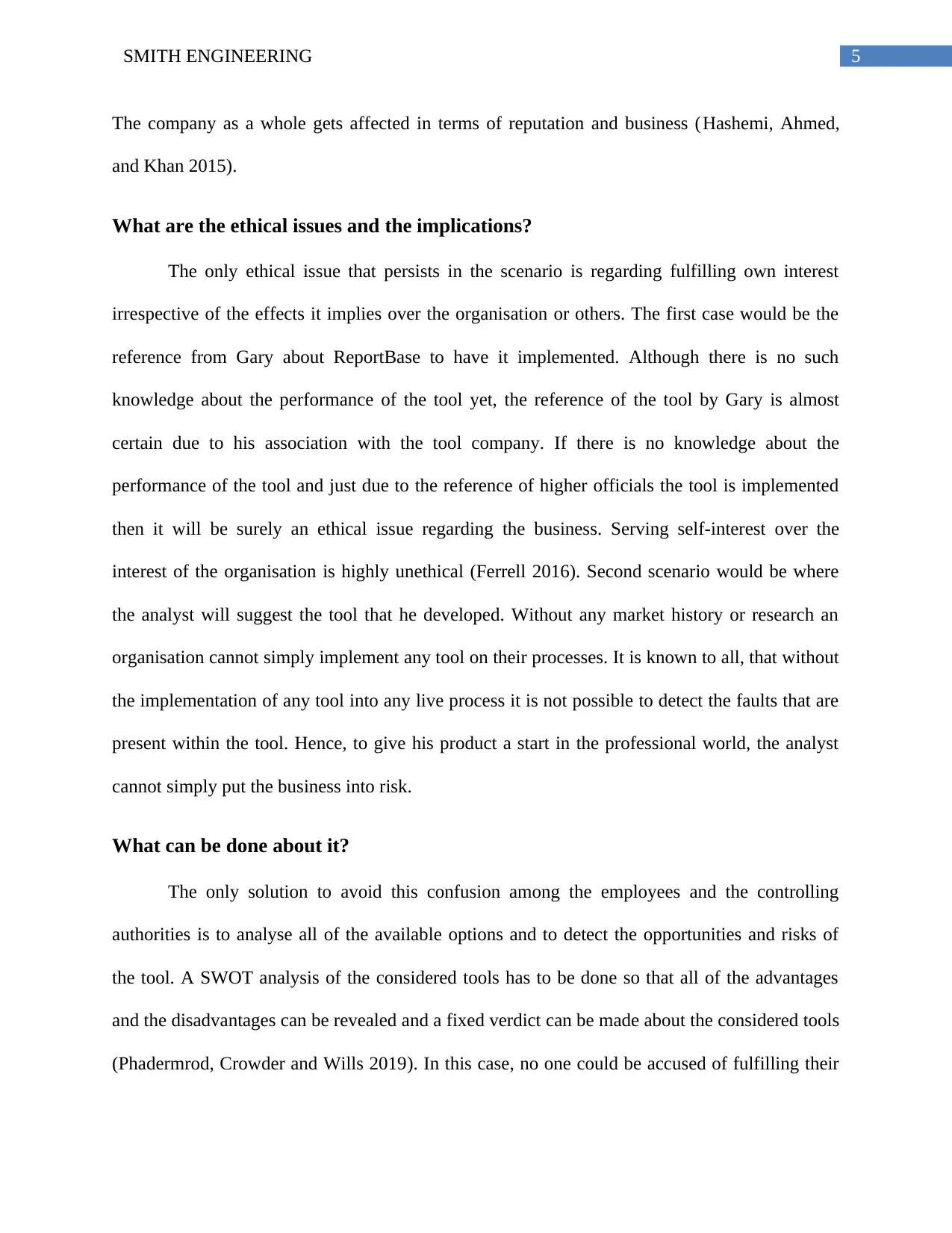
5SMITH ENGINEERING
The company as a whole gets affected in terms of reputation and business (Hashemi, Ahmed,
and Khan 2015).
What are the ethical issues and the implications?
The only ethical issue that persists in the scenario is regarding fulfilling own interest
irrespective of the effects it implies over the organisation or others. The first case would be the
reference from Gary about ReportBase to have it implemented. Although there is no such
knowledge about the performance of the tool yet, the reference of the tool by Gary is almost
certain due to his association with the tool company. If there is no knowledge about the
performance of the tool and just due to the reference of higher officials the tool is implemented
then it will be surely an ethical issue regarding the business. Serving self-interest over the
interest of the organisation is highly unethical (Ferrell 2016). Second scenario would be where
the analyst will suggest the tool that he developed. Without any market history or research an
organisation cannot simply implement any tool on their processes. It is known to all, that without
the implementation of any tool into any live process it is not possible to detect the faults that are
present within the tool. Hence, to give his product a start in the professional world, the analyst
cannot simply put the business into risk.
What can be done about it?
The only solution to avoid this confusion among the employees and the controlling
authorities is to analyse all of the available options and to detect the opportunities and risks of
the tool. A SWOT analysis of the considered tools has to be done so that all of the advantages
and the disadvantages can be revealed and a fixed verdict can be made about the considered tools
(Phadermrod, Crowder and Wills 2019). In this case, no one could be accused of fulfilling their
The company as a whole gets affected in terms of reputation and business (Hashemi, Ahmed,
and Khan 2015).
What are the ethical issues and the implications?
The only ethical issue that persists in the scenario is regarding fulfilling own interest
irrespective of the effects it implies over the organisation or others. The first case would be the
reference from Gary about ReportBase to have it implemented. Although there is no such
knowledge about the performance of the tool yet, the reference of the tool by Gary is almost
certain due to his association with the tool company. If there is no knowledge about the
performance of the tool and just due to the reference of higher officials the tool is implemented
then it will be surely an ethical issue regarding the business. Serving self-interest over the
interest of the organisation is highly unethical (Ferrell 2016). Second scenario would be where
the analyst will suggest the tool that he developed. Without any market history or research an
organisation cannot simply implement any tool on their processes. It is known to all, that without
the implementation of any tool into any live process it is not possible to detect the faults that are
present within the tool. Hence, to give his product a start in the professional world, the analyst
cannot simply put the business into risk.
What can be done about it?
The only solution to avoid this confusion among the employees and the controlling
authorities is to analyse all of the available options and to detect the opportunities and risks of
the tool. A SWOT analysis of the considered tools has to be done so that all of the advantages
and the disadvantages can be revealed and a fixed verdict can be made about the considered tools
(Phadermrod, Crowder and Wills 2019). In this case, no one could be accused of fulfilling their
⊘ This is a preview!⊘
Do you want full access?
Subscribe today to unlock all pages.

Trusted by 1+ million students worldwide
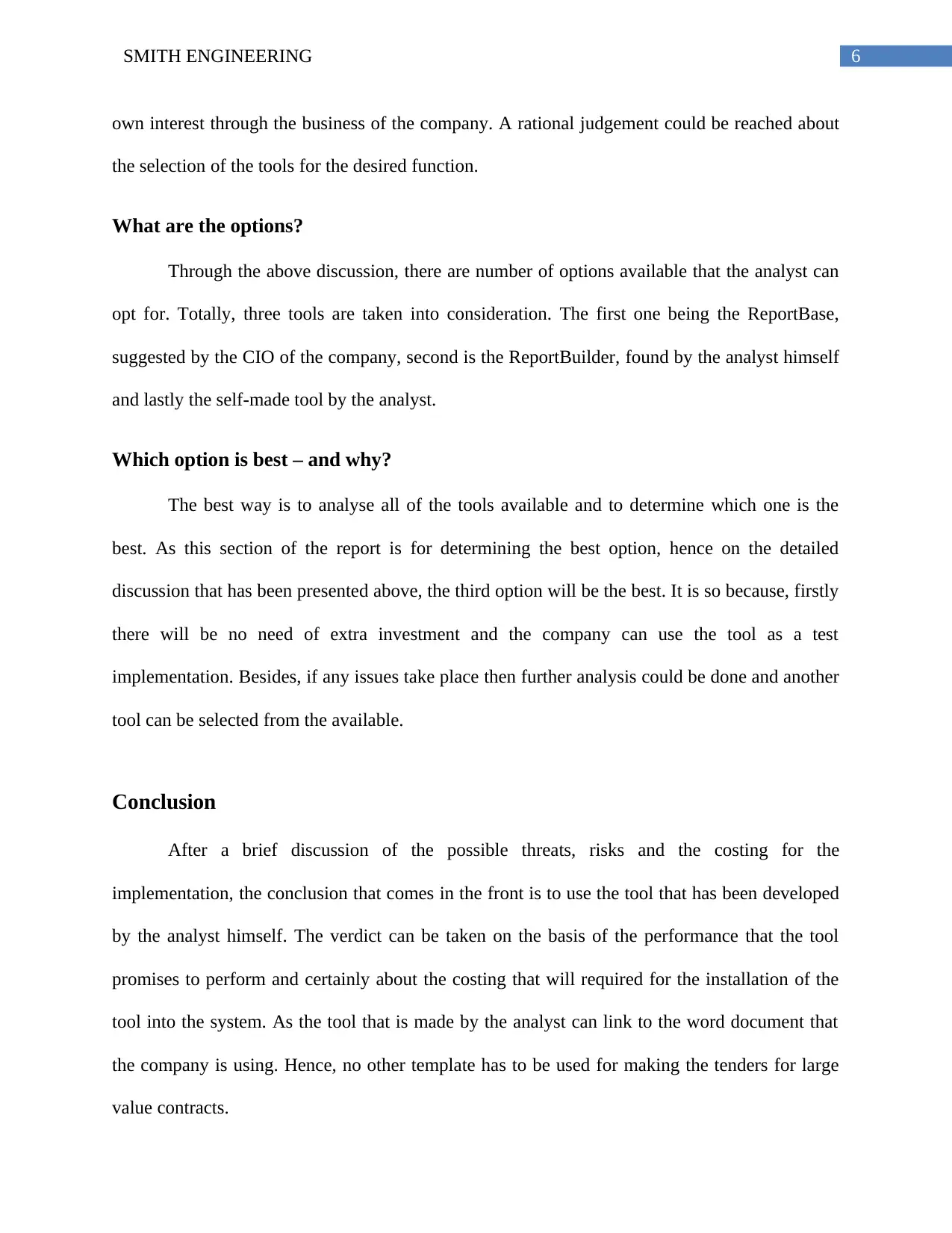
6SMITH ENGINEERING
own interest through the business of the company. A rational judgement could be reached about
the selection of the tools for the desired function.
What are the options?
Through the above discussion, there are number of options available that the analyst can
opt for. Totally, three tools are taken into consideration. The first one being the ReportBase,
suggested by the CIO of the company, second is the ReportBuilder, found by the analyst himself
and lastly the self-made tool by the analyst.
Which option is best – and why?
The best way is to analyse all of the tools available and to determine which one is the
best. As this section of the report is for determining the best option, hence on the detailed
discussion that has been presented above, the third option will be the best. It is so because, firstly
there will be no need of extra investment and the company can use the tool as a test
implementation. Besides, if any issues take place then further analysis could be done and another
tool can be selected from the available.
Conclusion
After a brief discussion of the possible threats, risks and the costing for the
implementation, the conclusion that comes in the front is to use the tool that has been developed
by the analyst himself. The verdict can be taken on the basis of the performance that the tool
promises to perform and certainly about the costing that will required for the installation of the
tool into the system. As the tool that is made by the analyst can link to the word document that
the company is using. Hence, no other template has to be used for making the tenders for large
value contracts.
own interest through the business of the company. A rational judgement could be reached about
the selection of the tools for the desired function.
What are the options?
Through the above discussion, there are number of options available that the analyst can
opt for. Totally, three tools are taken into consideration. The first one being the ReportBase,
suggested by the CIO of the company, second is the ReportBuilder, found by the analyst himself
and lastly the self-made tool by the analyst.
Which option is best – and why?
The best way is to analyse all of the tools available and to determine which one is the
best. As this section of the report is for determining the best option, hence on the detailed
discussion that has been presented above, the third option will be the best. It is so because, firstly
there will be no need of extra investment and the company can use the tool as a test
implementation. Besides, if any issues take place then further analysis could be done and another
tool can be selected from the available.
Conclusion
After a brief discussion of the possible threats, risks and the costing for the
implementation, the conclusion that comes in the front is to use the tool that has been developed
by the analyst himself. The verdict can be taken on the basis of the performance that the tool
promises to perform and certainly about the costing that will required for the installation of the
tool into the system. As the tool that is made by the analyst can link to the word document that
the company is using. Hence, no other template has to be used for making the tenders for large
value contracts.
Paraphrase This Document
Need a fresh take? Get an instant paraphrase of this document with our AI Paraphraser
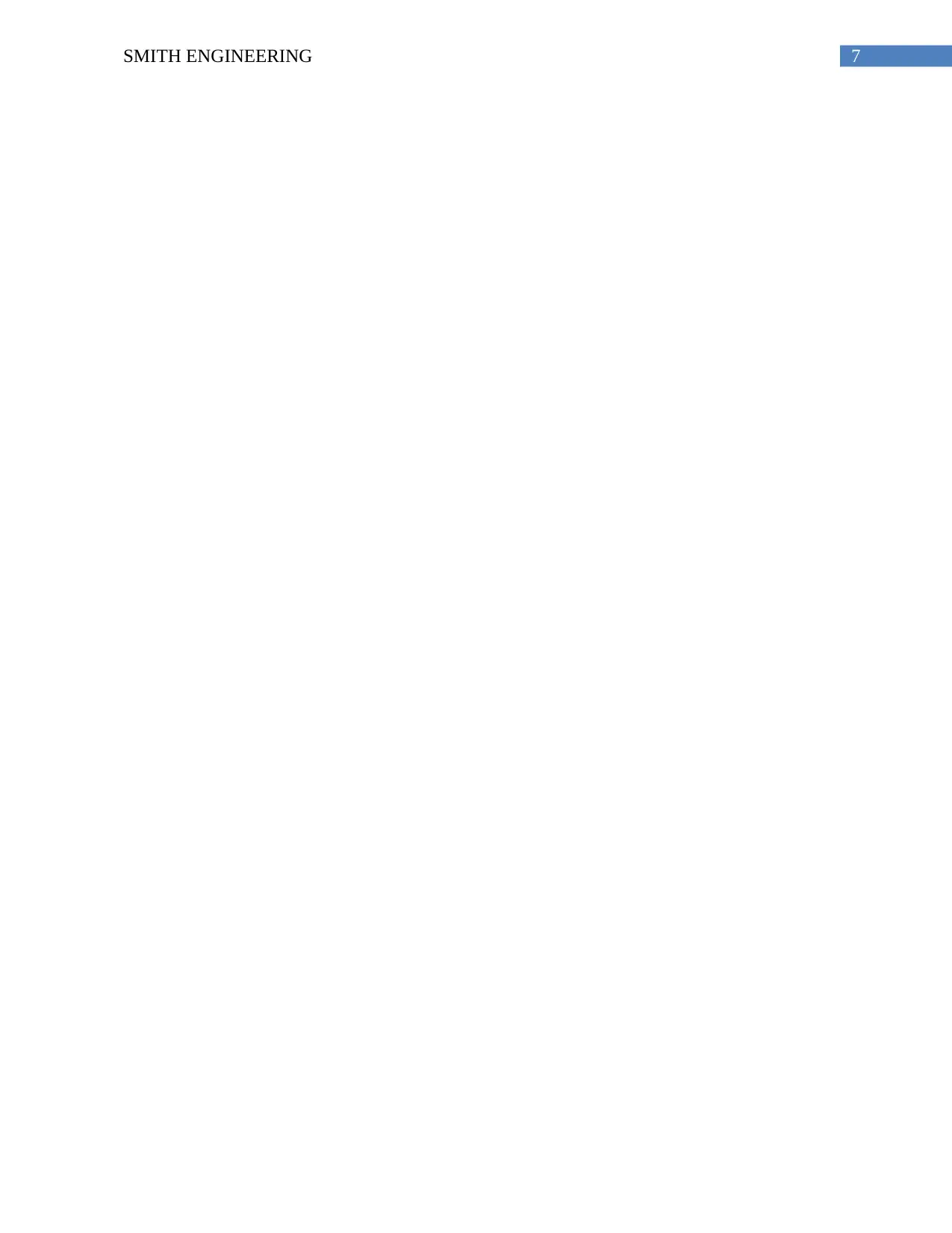
7SMITH ENGINEERING
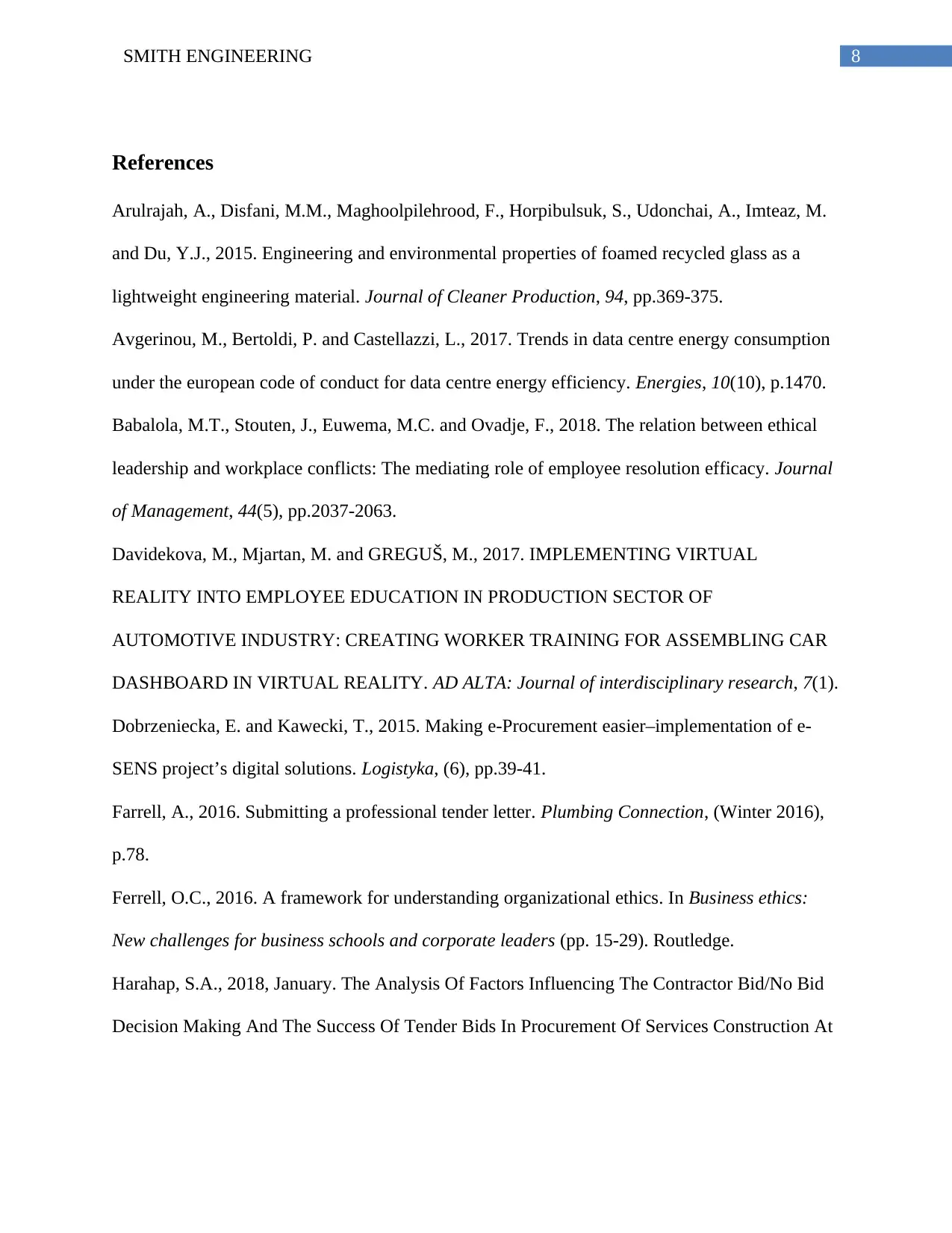
8SMITH ENGINEERING
References
Arulrajah, A., Disfani, M.M., Maghoolpilehrood, F., Horpibulsuk, S., Udonchai, A., Imteaz, M.
and Du, Y.J., 2015. Engineering and environmental properties of foamed recycled glass as a
lightweight engineering material. Journal of Cleaner Production, 94, pp.369-375.
Avgerinou, M., Bertoldi, P. and Castellazzi, L., 2017. Trends in data centre energy consumption
under the european code of conduct for data centre energy efficiency. Energies, 10(10), p.1470.
Babalola, M.T., Stouten, J., Euwema, M.C. and Ovadje, F., 2018. The relation between ethical
leadership and workplace conflicts: The mediating role of employee resolution efficacy. Journal
of Management, 44(5), pp.2037-2063.
Davidekova, M., Mjartan, M. and GREGUŠ, M., 2017. IMPLEMENTING VIRTUAL
REALITY INTO EMPLOYEE EDUCATION IN PRODUCTION SECTOR OF
AUTOMOTIVE INDUSTRY: CREATING WORKER TRAINING FOR ASSEMBLING CAR
DASHBOARD IN VIRTUAL REALITY. AD ALTA: Journal of interdisciplinary research, 7(1).
Dobrzeniecka, E. and Kawecki, T., 2015. Making e-Procurement easier–implementation of e-
SENS project’s digital solutions. Logistyka, (6), pp.39-41.
Farrell, A., 2016. Submitting a professional tender letter. Plumbing Connection, (Winter 2016),
p.78.
Ferrell, O.C., 2016. A framework for understanding organizational ethics. In Business ethics:
New challenges for business schools and corporate leaders (pp. 15-29). Routledge.
Harahap, S.A., 2018, January. The Analysis Of Factors Influencing The Contractor Bid/No Bid
Decision Making And The Success Of Tender Bids In Procurement Of Services Construction At
References
Arulrajah, A., Disfani, M.M., Maghoolpilehrood, F., Horpibulsuk, S., Udonchai, A., Imteaz, M.
and Du, Y.J., 2015. Engineering and environmental properties of foamed recycled glass as a
lightweight engineering material. Journal of Cleaner Production, 94, pp.369-375.
Avgerinou, M., Bertoldi, P. and Castellazzi, L., 2017. Trends in data centre energy consumption
under the european code of conduct for data centre energy efficiency. Energies, 10(10), p.1470.
Babalola, M.T., Stouten, J., Euwema, M.C. and Ovadje, F., 2018. The relation between ethical
leadership and workplace conflicts: The mediating role of employee resolution efficacy. Journal
of Management, 44(5), pp.2037-2063.
Davidekova, M., Mjartan, M. and GREGUŠ, M., 2017. IMPLEMENTING VIRTUAL
REALITY INTO EMPLOYEE EDUCATION IN PRODUCTION SECTOR OF
AUTOMOTIVE INDUSTRY: CREATING WORKER TRAINING FOR ASSEMBLING CAR
DASHBOARD IN VIRTUAL REALITY. AD ALTA: Journal of interdisciplinary research, 7(1).
Dobrzeniecka, E. and Kawecki, T., 2015. Making e-Procurement easier–implementation of e-
SENS project’s digital solutions. Logistyka, (6), pp.39-41.
Farrell, A., 2016. Submitting a professional tender letter. Plumbing Connection, (Winter 2016),
p.78.
Ferrell, O.C., 2016. A framework for understanding organizational ethics. In Business ethics:
New challenges for business schools and corporate leaders (pp. 15-29). Routledge.
Harahap, S.A., 2018, January. The Analysis Of Factors Influencing The Contractor Bid/No Bid
Decision Making And The Success Of Tender Bids In Procurement Of Services Construction At
⊘ This is a preview!⊘
Do you want full access?
Subscribe today to unlock all pages.

Trusted by 1+ million students worldwide
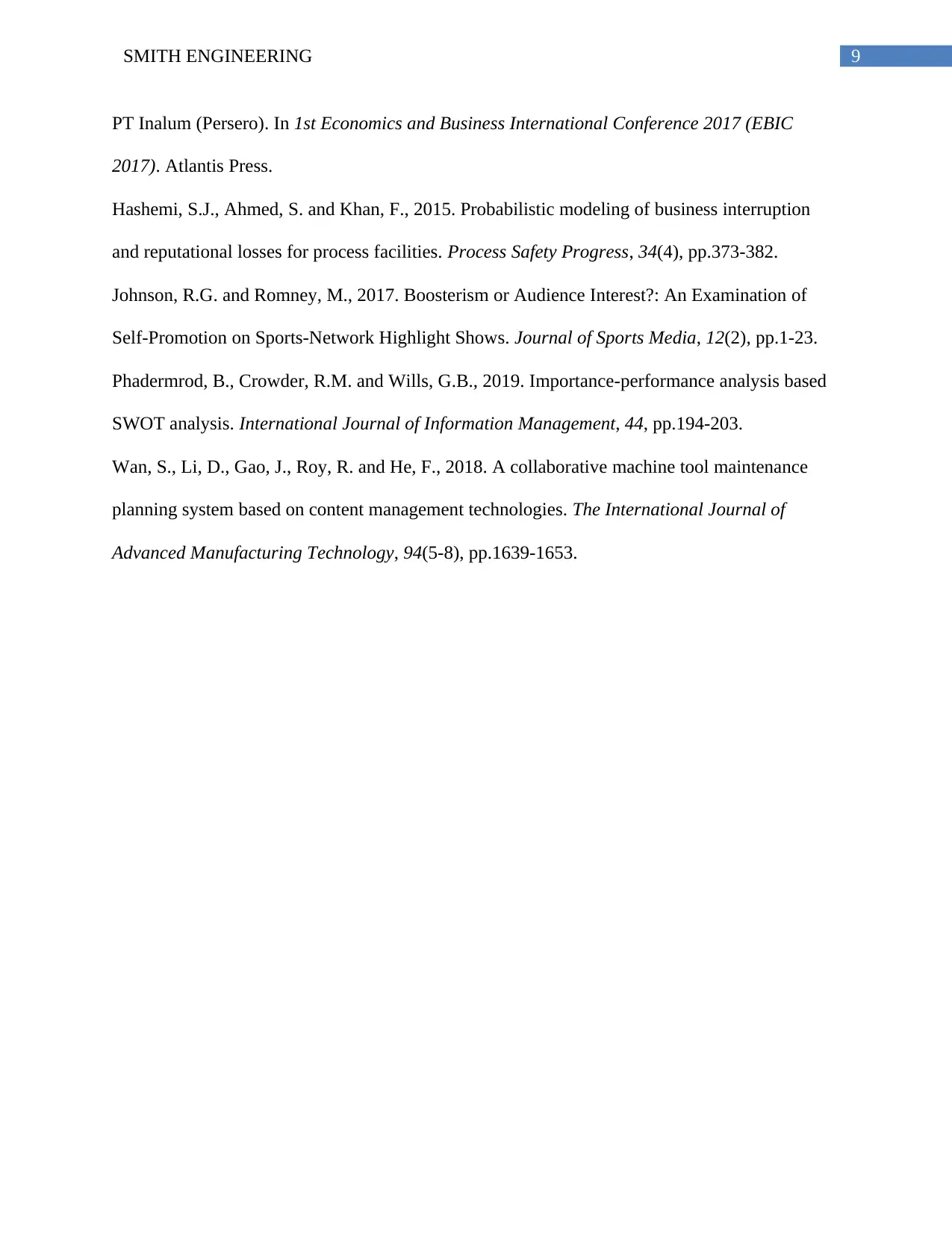
9SMITH ENGINEERING
PT Inalum (Persero). In 1st Economics and Business International Conference 2017 (EBIC
2017). Atlantis Press.
Hashemi, S.J., Ahmed, S. and Khan, F., 2015. Probabilistic modeling of business interruption
and reputational losses for process facilities. Process Safety Progress, 34(4), pp.373-382.
Johnson, R.G. and Romney, M., 2017. Boosterism or Audience Interest?: An Examination of
Self-Promotion on Sports-Network Highlight Shows. Journal of Sports Media, 12(2), pp.1-23.
Phadermrod, B., Crowder, R.M. and Wills, G.B., 2019. Importance-performance analysis based
SWOT analysis. International Journal of Information Management, 44, pp.194-203.
Wan, S., Li, D., Gao, J., Roy, R. and He, F., 2018. A collaborative machine tool maintenance
planning system based on content management technologies. The International Journal of
Advanced Manufacturing Technology, 94(5-8), pp.1639-1653.
PT Inalum (Persero). In 1st Economics and Business International Conference 2017 (EBIC
2017). Atlantis Press.
Hashemi, S.J., Ahmed, S. and Khan, F., 2015. Probabilistic modeling of business interruption
and reputational losses for process facilities. Process Safety Progress, 34(4), pp.373-382.
Johnson, R.G. and Romney, M., 2017. Boosterism or Audience Interest?: An Examination of
Self-Promotion on Sports-Network Highlight Shows. Journal of Sports Media, 12(2), pp.1-23.
Phadermrod, B., Crowder, R.M. and Wills, G.B., 2019. Importance-performance analysis based
SWOT analysis. International Journal of Information Management, 44, pp.194-203.
Wan, S., Li, D., Gao, J., Roy, R. and He, F., 2018. A collaborative machine tool maintenance
planning system based on content management technologies. The International Journal of
Advanced Manufacturing Technology, 94(5-8), pp.1639-1653.
1 out of 10
Your All-in-One AI-Powered Toolkit for Academic Success.
+13062052269
info@desklib.com
Available 24*7 on WhatsApp / Email
![[object Object]](/_next/static/media/star-bottom.7253800d.svg)
Unlock your academic potential
Copyright © 2020–2025 A2Z Services. All Rights Reserved. Developed and managed by ZUCOL.


